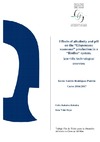Please use this identifier to cite or link to this item:
https://accedacris.ulpgc.es/jspui/handle/10553/74905
| Title: | Effects of alkalinity and pH on the "Litopenaeus vannamei" production in a "Biofloc" system : scientific technological overview | Authors: | Rodríguez Padrón, Kevin Andrés | Director: | Robaina Robaina, Lidia Esther Vidal Payá, Iván |
UNESCO Clasification: | 251092 Acuicultura marina | Keywords: | Alkalinity pH Litopenaeus vannamei |
Issue Date: | 2017 | Abstract: | "Litopenaeus vannamei" or White Shrimp is reared on several types of systems. The
early breeding stages of this species, using biofloc technologies, involve the formation
process of bioflocs. The increase of the suspended solids causes the parameters of
Alkalinity and pH to fluctuate constantly, by means of the consumption of inorganic
carbon of the autotrophic bacteria present in the bioflocs. The changes of pH can
produce sub-lethal effects for this organism coming to modify the physical,
zootechnical, enzymatic and molecular properties that can affect until its survival. The
objective of the present study is to made and scientific technological overview to better
understand the changes that occur in the organism, both positive and negative, produced
by fluctuations of pH and alkalinity in the culture water system, in order to reach
optimal levels and adequate for their survival. The study consists of the compilation of
results of different experiments with acid and basic pH treatments, with levels from 3.5
to 11, and alkalinities from 75 to 300 mg CaCO3 / L, to determine the effect of these
different levels on the organism at different physiological levels. It has been possible to
conclude that the more acidic and more basic values are harmful to the organism, the
worst being the most acidic levels, with an optimal survival range between 7.5 and 8.5.
As for alkalinity, the most harmful values that affect mainly the zootechnical
performance are those below 75 mg CaCO3 / L and above 300 mg CaCO3 / L being
values between 100/150 and 300 mg CaCO3 / L the most suitable. "Litopenaeus vannamei" o camarón blanco se cría en varios tipos de sistemas. Las etapas de cría temprana de esta especie, utilizando tecnologías de biofloc, implican el proceso de formación de bioflocs. El aumento de los sólidos en suspensión hace que los parámetros de alcalinidad y pH fluctúen constantemente, mediante el consumo de carbono inorgánico de las bacterias autotróficas presentes en los bioflocos. Los cambios de pH pueden producir efectos sub-letales para este organismo que vienen a modificar las propiedades físicas, zootécnicas, enzimáticas y moleculares, pudiendo afectar incluso a su supervivencia. El objetivo de este estudio es verificar y evaluar los cambios que se producen en el organismo, tanto positivos como negativos, producidos por fluctuaciones de pH y alcalinidad, para determinar niveles óptimos y adecuados para su supervivencia. El estudio consiste en la recopilación de resultados de diferentes experimentos con tratamientos de pH ácido y básico, con niveles de 3,5 a 11 y alcalinidades de 75 a 300 mg CaCO3 / L, para determinar el efecto en el organismo de estos diferentes niveles a diferentes niveles fisiológicos. Se ha podido concluir que los valores más ácidos y más básicos son perjudiciales para el organismo, siendo los peores los niveles más ácidos, con un rango óptimo de supervivencia entre 7,5 y 8,5. En cuanto a la alcalinidad, los valores más nocivos que afectan principalmente al rendimiento zootécnico están por debajo de 75 mg CaCO3 / L y por encima de 300 mg CaCO3 / L , siendo el rango entre 100/150 y 300 mg CaCO3 / L el más adecuado. |
Department: | Departamento de Biología | Faculty: | Facultad de Ciencias del Mar | Degree: | Grado en Ciencias del Mar | URI: | https://accedacris.ulpgc.es/handle/10553/74905 |
| Appears in Collections: | Trabajo final de grado Restringido ULPGC |
En el caso de que no encuentre el documento puede ser debido a que el centro o las/os autoras/es no autorizan su publicación. Si tiene verdadero interés en el contenido del mismo, puede dirigirse al director/a o directores/as del trabajo cuyos datos encontrará más arriba.
Show full item recordPage view(s)
85
checked on Mar 9, 2024
Download(s)
23
checked on Mar 9, 2024
Google ScholarTM
Check
Share
Export metadata
Items in accedaCRIS are protected by copyright, with all rights reserved, unless otherwise indicated.
